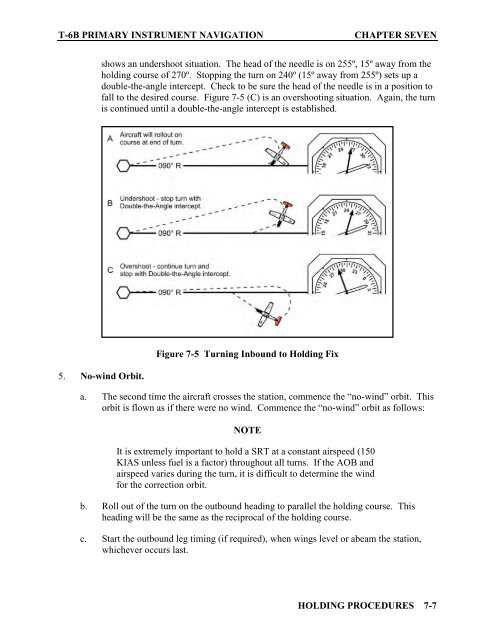Flight Training Instruction - Cnatra - U.S. Navy
Flight Training Instruction - Cnatra - U.S. Navy
Flight Training Instruction - Cnatra - U.S. Navy
Create successful ePaper yourself
Turn your PDF publications into a flip-book with our unique Google optimized e-Paper software.
T-6B PRIMARY INSTRUMENT NAVIGATION CHAPTER SEVEN<br />
shows an undershoot situation. The head of the needle is on 255º, 15º away from the<br />
holding course of 270º. Stopping the turn on 240º (15º away from 255º) sets up a<br />
double-the-angle intercept. Check to be sure the head of the needle is in a position to<br />
fall to the desired course. Figure 7-5 (C) is an overshooting situation. Again, the turn<br />
is continued until a double-the-angle intercept is established.<br />
5. No-wind Orbit.<br />
Figure 7-5 Turning Inbound to Holding Fix<br />
a. The second time the aircraft crosses the station, commence the “no-wind” orbit. This<br />
orbit is flown as if there were no wind. Commence the “no-wind” orbit as follows:<br />
NOTE<br />
It is extremely important to hold a SRT at a constant airspeed (150<br />
KIAS unless fuel is a factor) throughout all turns. If the AOB and<br />
airspeed varies during the turn, it is difficult to determine the wind<br />
for the correction orbit.<br />
b. Roll out of the turn on the outbound heading to parallel the holding course. This<br />
heading will be the same as the reciprocal of the holding course.<br />
c. Start the outbound leg timing (if required), when wings level or abeam the station,<br />
whichever occurs last.<br />
HOLDING PROCEDURES 7-7
















